THAT WAS DONE AT THE INSTIGATION OF THE LEGAL COUNSEL FOR PARSONS BRINCKERHOFF.
THEIR REASONS ARE STATED BELOW.
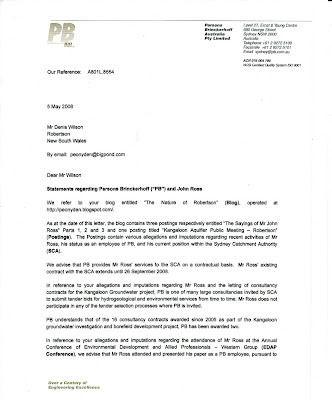
 THIS BLOG RESERVES THE RIGHT TO EXPLORE ISSUES OF PUBLIC ACCOUNTABILITY.
THIS BLOG RESERVES THE RIGHT TO EXPLORE ISSUES OF PUBLIC ACCOUNTABILITY.A BLOG ABOUT THE NATURE OF ROBERTSON, NSW, AUSTRALIA
ABOUT THINGS WHICH GROW HERE, NATURALLY; SOME OF MY SPECIAL INTERESTS - NATIVE PLANTS AND INSECTS, AND CULTIVARS OF PEONIES AND ROSES WHICH I GROW.
AND ABOUT LIFE IN ROBERTSON, TOO.


 THIS BLOG RESERVES THE RIGHT TO EXPLORE ISSUES OF PUBLIC ACCOUNTABILITY.
THIS BLOG RESERVES THE RIGHT TO EXPLORE ISSUES OF PUBLIC ACCOUNTABILITY.
 THIS BLOG RESERVES THE RIGHT TO EXPLORE ISSUES OF PUBLIC ACCOUNTABILITY.
THIS BLOG RESERVES THE RIGHT TO EXPLORE ISSUES OF PUBLIC ACCOUNTABILITY.
 THIS BLOG RESERVES THE RIGHT TO EXPLORE ISSUES OF PUBLIC ACCOUNTABILITY.
THIS BLOG RESERVES THE RIGHT TO EXPLORE ISSUES OF PUBLIC ACCOUNTABILITY.
PUBLIC MEETING
SATURDAY 3RD MAY
What the
will not tell you!
ROBERTSON SCHOOL OF ARTS
5.OO PM
ALL WELCOME
Meeting is convened by Save Water Alliance
 I ask, what does Mr John Ross say to that? I stand ready to publish any reply from Mr Ross, or Mr Tanner, the Acting Chief Executive of the SCA.
I ask, what does Mr John Ross say to that? I stand ready to publish any reply from Mr Ross, or Mr Tanner, the Acting Chief Executive of the SCA. So I wonder how much that cost has blown out since then?
So I wonder how much that cost has blown out since then? This plant is a left over from a revision of the genus Eriostemon. Nearly all the others (if not all of the original members of that genus) are now classed as "Philotheca". This plant is known from other areas, but apparently the Hilltop to Thirlmere area is one of its strongholds. A lovely clear flower.
This plant is a left over from a revision of the genus Eriostemon. Nearly all the others (if not all of the original members of that genus) are now classed as "Philotheca". This plant is known from other areas, but apparently the Hilltop to Thirlmere area is one of its strongholds. A lovely clear flower. Both these plants were flowering happily at Hilltop, just near the proposed Regional Shooting Centre. Unfortunately I did not find any Orchids in this part of the trip.
Both these plants were flowering happily at Hilltop, just near the proposed Regional Shooting Centre. Unfortunately I did not find any Orchids in this part of the trip.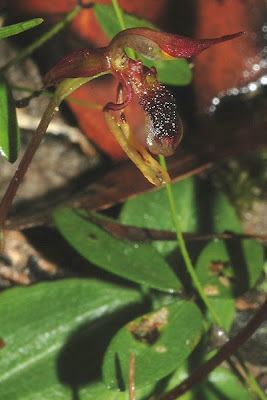 In this image (a bit blurry, sorry, but I refused to lie down in the mud to photograph these plants more closely) you can see the clubs bent down, then forward underneath the body of the flower. Other Chiloglottis I have seen this autumn have their clubs bent out wide and backwards, or straight down. Also this one has clubs which are clearly yellow for most of their length. Previously published photos of Ch. seminuda and Ch. reflexa may be found at those individual links.
In this image (a bit blurry, sorry, but I refused to lie down in the mud to photograph these plants more closely) you can see the clubs bent down, then forward underneath the body of the flower. Other Chiloglottis I have seen this autumn have their clubs bent out wide and backwards, or straight down. Also this one has clubs which are clearly yellow for most of their length. Previously published photos of Ch. seminuda and Ch. reflexa may be found at those individual links.  Another intriguing plant group is these Greenhoods, which I am as yet unable to identify.
Another intriguing plant group is these Greenhoods, which I am as yet unable to identify. Clearly they are a type of Greenhood, but what? Tiny thin buds, but very small. They are only on stems about 2 inches high. Even though they are not fully expanded, it looks like they are going to be only small flowers. A 20 cent coin is there for scale. I spoke with a local Macarthur Branch ANOS member, Wally Southwell about them tonight, but he did not know what they were likely to be (from my vague description over the phone). I have sent him several photographs, and hope to hear back from him.
Clearly they are a type of Greenhood, but what? Tiny thin buds, but very small. They are only on stems about 2 inches high. Even though they are not fully expanded, it looks like they are going to be only small flowers. A 20 cent coin is there for scale. I spoke with a local Macarthur Branch ANOS member, Wally Southwell about them tonight, but he did not know what they were likely to be (from my vague description over the phone). I have sent him several photographs, and hope to hear back from him.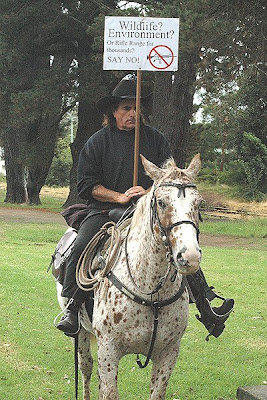 Today there were people shooting, and I could hear the rifle cracks from about 2 Km away from their front gate. The expected impact of noise from a greatly increased operation, and the long operating hours, especially at night has many people worried.
Today there were people shooting, and I could hear the rifle cracks from about 2 Km away from their front gate. The expected impact of noise from a greatly increased operation, and the long operating hours, especially at night has many people worried. Many groups, including the National Parks Association (of which I am a member) supported the locals. Here Tony Hill, NPA Chairman is speaking. He was critical that the area for the expanded shooting facility has been excised from the Bargo State Conservation Area. Also there are significant environmental issues, especially associated with the effects of lead which will be released into the local environment as a result of the shooting.
Many groups, including the National Parks Association (of which I am a member) supported the locals. Here Tony Hill, NPA Chairman is speaking. He was critical that the area for the expanded shooting facility has been excised from the Bargo State Conservation Area. Also there are significant environmental issues, especially associated with the effects of lead which will be released into the local environment as a result of the shooting. Councillor Malcolm Murray spoke against the proposal, mostly being very critical of the fact that Minister Frank Sartor has deemed the project a State Significant Project, thus removing any rights of appeal from the local community, and also removing any authority the Council might have normally had. Lee Rhiannon, Greens MLC member (in the background in this image) also spoke against the proposal.
Councillor Malcolm Murray spoke against the proposal, mostly being very critical of the fact that Minister Frank Sartor has deemed the project a State Significant Project, thus removing any rights of appeal from the local community, and also removing any authority the Council might have normally had. Lee Rhiannon, Greens MLC member (in the background in this image) also spoke against the proposal. Jan (a member of NPA) was there supporting John, a local horse-rider, and child with his pony, all bearing signs protesting against the expansion of the SHRC facility. Locals are concerned primarily about the noise, and safety issues, and the horse-riders are concerned about horses getting "spooked", with resultant risks to riders, especially young children.
Jan (a member of NPA) was there supporting John, a local horse-rider, and child with his pony, all bearing signs protesting against the expansion of the SHRC facility. Locals are concerned primarily about the noise, and safety issues, and the horse-riders are concerned about horses getting "spooked", with resultant risks to riders, especially young children. Will Frank Sartor take any notice? If Lee Rhiannon's theory that it is a deal stitched up with the Shooters' Party, then it is unlikely that he will.
Will Frank Sartor take any notice? If Lee Rhiannon's theory that it is a deal stitched up with the Shooters' Party, then it is unlikely that he will.
 Photo courtesy of Cam. Ford - "Save the Highlands"
Photo courtesy of Cam. Ford - "Save the Highlands" This was an exercise in futility, from the start, to the finish.
This was an exercise in futility, from the start, to the finish. Exhibit B: Corunastylis species, probably C. oligantha. This species is newly classified, and the name does not appear on PlantNET, and a Google image search draws a blank. That makes it hard. The only reference I have, so far, is David Jones's book. Tony Bishop's book had good photos of this plant, but the species had not been named when his book was published. Good as the Jones book is, the photos are not really enough for me to make an absolute identification. I hope to print these images, and show them to some Orchid experts shortly.
Exhibit B: Corunastylis species, probably C. oligantha. This species is newly classified, and the name does not appear on PlantNET, and a Google image search draws a blank. That makes it hard. The only reference I have, so far, is David Jones's book. Tony Bishop's book had good photos of this plant, but the species had not been named when his book was published. Good as the Jones book is, the photos are not really enough for me to make an absolute identification. I hope to print these images, and show them to some Orchid experts shortly.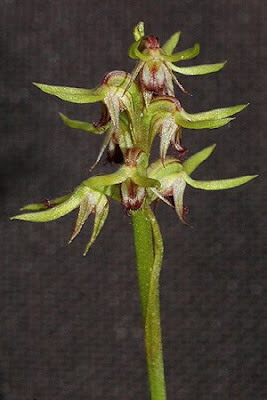
 Here is a comparison photo of the dorsal sepal of the two species mentioned above. The Medway plant C. oligantha (?) is on the right. Clearly the dorsal sepal does not have fringed edges. Whereas the other plant does. The reason I stress this is that I was told, originally, that based upon the locality, the flowers I had found were likely to be C. fimbriata. Clearly the plant on the right is not "fringed " on the dorsal sepal (which is a definite feature for that species). So, that rules out C. fimbriata. The next best "fit" is C. oligantha, but it is not recorded from anywhere near here. See my problem?
Here is a comparison photo of the dorsal sepal of the two species mentioned above. The Medway plant C. oligantha (?) is on the right. Clearly the dorsal sepal does not have fringed edges. Whereas the other plant does. The reason I stress this is that I was told, originally, that based upon the locality, the flowers I had found were likely to be C. fimbriata. Clearly the plant on the right is not "fringed " on the dorsal sepal (which is a definite feature for that species). So, that rules out C. fimbriata. The next best "fit" is C. oligantha, but it is not recorded from anywhere near here. See my problem? I subsequently went with Alan Stephenson, to Tallong, in search of C. plumosa, a geographically restricted (endemic) species. We did not find that species, but we did find this next plant (below).
I subsequently went with Alan Stephenson, to Tallong, in search of C. plumosa, a geographically restricted (endemic) species. We did not find that species, but we did find this next plant (below).
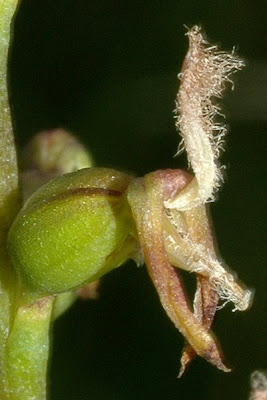
 After the boys in red jackets finished warming up the crowd, the wild boys hit the stage. Nick Rheinberger got them going with some old fashioned rock 'n roll. He invited Andy Ford to join the band in a rendition of Van Morrison's "Gloria". That was a natural choice, for Andy has co-authored a book on the songs of "Van the Man". It is called "Speaking in Tongues"
After the boys in red jackets finished warming up the crowd, the wild boys hit the stage. Nick Rheinberger got them going with some old fashioned rock 'n roll. He invited Andy Ford to join the band in a rendition of Van Morrison's "Gloria". That was a natural choice, for Andy has co-authored a book on the songs of "Van the Man". It is called "Speaking in Tongues"  The CTC had hosted a book launch by Andy Ford and Martin Buzacott on 26 May 2005. Gosh, it hardly seems that long ago. Photos of that event are on the CTC website - News Archive for that date. Here you can see the band winding up for a big finale at the end of "Gloria". Nick is about to bring it a big conclusion, and Andy is getting into it pretty seriously, too.
The CTC had hosted a book launch by Andy Ford and Martin Buzacott on 26 May 2005. Gosh, it hardly seems that long ago. Photos of that event are on the CTC website - News Archive for that date. Here you can see the band winding up for a big finale at the end of "Gloria". Nick is about to bring it a big conclusion, and Andy is getting into it pretty seriously, too. Here are two of the members of the CTC house band. Richard, who is one of the co-ordinators of the CTC Music Nights, and Brian, who is a regular performer. Brian was also the stand-in conductor for the "Highland-Dares" as seen in the first photo, above. (He changed out of the red jacket.)
Here are two of the members of the CTC house band. Richard, who is one of the co-ordinators of the CTC Music Nights, and Brian, who is a regular performer. Brian was also the stand-in conductor for the "Highland-Dares" as seen in the first photo, above. (He changed out of the red jacket.) Thanks again to Sally, for sending me the photos, as I had come rushing back from Canberra for the book launch, and I did not have my own camera with me.
Thanks again to Sally, for sending me the photos, as I had come rushing back from Canberra for the book launch, and I did not have my own camera with me.
 The RHRS also hosted a visit by the Historic Rail Motor CPH 18, which ran 6 short trips, back and forth to Mt Murray Station (to the east of Robertson) and to Calwalla (to the west).
The RHRS also hosted a visit by the Historic Rail Motor CPH 18, which ran 6 short trips, back and forth to Mt Murray Station (to the east of Robertson) and to Calwalla (to the west). 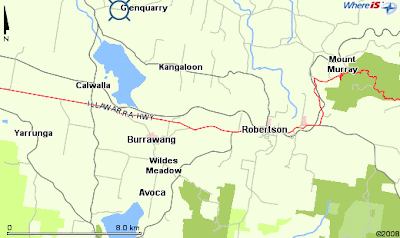 In addition, the regular "Cockatoo Run" train visit to Robertson is now linked to a bus connection to Knights Hill, for persons wishing to make the trip from Sydney via train, and to include a visit to the Illawarra Fly.
In addition, the regular "Cockatoo Run" train visit to Robertson is now linked to a bus connection to Knights Hill, for persons wishing to make the trip from Sydney via train, and to include a visit to the Illawarra Fly.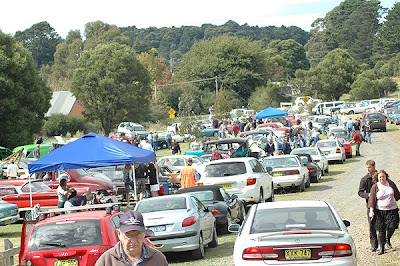 After clear weather in the middle of the day, in the late afternoon the sky darkened out over the Macquarie Pass escarpment. I decided to go and shoot the threatening clouds.
After clear weather in the middle of the day, in the late afternoon the sky darkened out over the Macquarie Pass escarpment. I decided to go and shoot the threatening clouds. Out on the Mt Murray Road there is a little-known place where there is an amazing perspective on the cliffs over the top of the Macquarie Pass. You can literally see the clouds forming, as the moist afternoon air rose over the rocks, just in front of my camera.
Out on the Mt Murray Road there is a little-known place where there is an amazing perspective on the cliffs over the top of the Macquarie Pass. You can literally see the clouds forming, as the moist afternoon air rose over the rocks, just in front of my camera.  And the late afternoon skies were even more dramatic as the lights came on down in Albion Park, way below me. More mist-forming is evident in this image, too.
And the late afternoon skies were even more dramatic as the lights came on down in Albion Park, way below me. More mist-forming is evident in this image, too.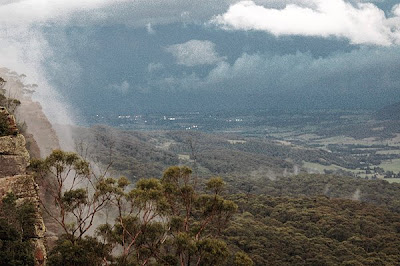 My favourite shot of the very top of Macquarie Pass. The trees on these cliffs overlook the last stretch of the Pass (the Illawarra Highway passes directly below that point). A steep and somewhat dangerous place to visit, but it looked very striking with the threatening clouds.
My favourite shot of the very top of Macquarie Pass. The trees on these cliffs overlook the last stretch of the Pass (the Illawarra Highway passes directly below that point). A steep and somewhat dangerous place to visit, but it looked very striking with the threatening clouds. I love the way the changing light makes the whole world look different, minute by minute. Here I was in a different place, a different world even, from the hurly-burly of the afternoon. But I was just 5 kilometres away from Robertson.
I love the way the changing light makes the whole world look different, minute by minute. Here I was in a different place, a different world even, from the hurly-burly of the afternoon. But I was just 5 kilometres away from Robertson.

 Anyway, after just a few minutes of this performance, the male had some success, for a female paddled very directly across the reservoir from the reed-bank on the far side of the reservoir.
Anyway, after just a few minutes of this performance, the male had some success, for a female paddled very directly across the reservoir from the reed-bank on the far side of the reservoir.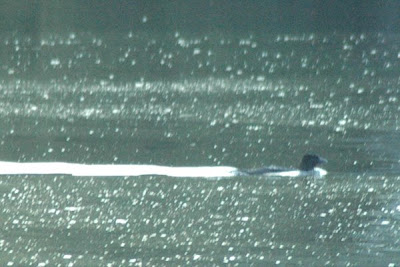

 If you did not know that you were looking at Musk Ducks, you could be forgiven for thinking you had seen a very small, Southern Highlands version of the Loch Ness Monster.
If you did not know that you were looking at Musk Ducks, you could be forgiven for thinking you had seen a very small, Southern Highlands version of the Loch Ness Monster. However, the small animals resident in the entire burnt area, and the understory plants are at severe risk because of the intensity of that burning. And the fact that there are not "refugia" (areas which were not burnt off) is the most damaging part of this entire process. These areas which are supposed to be left unburnt, are meant to serve not only as "refuges" for animals (especially small animals), but also as "seed banks " for plants. I remind you that along Tourist Road, roughly 9 Km of forest was burnt, with only three small gaps adjacent to creeks, which were not burnt.
However, the small animals resident in the entire burnt area, and the understory plants are at severe risk because of the intensity of that burning. And the fact that there are not "refugia" (areas which were not burnt off) is the most damaging part of this entire process. These areas which are supposed to be left unburnt, are meant to serve not only as "refuges" for animals (especially small animals), but also as "seed banks " for plants. I remind you that along Tourist Road, roughly 9 Km of forest was burnt, with only three small gaps adjacent to creeks, which were not burnt. detail of burnt-out swamp
detail of burnt-out swamp northern end of same swamp, burnt out
northern end of same swamp, burnt out
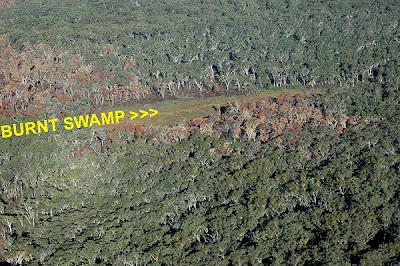 If, as I was told by Mr Lambkin on 24 March, it is the SCA's policy that they never burn the swamps, I can only conclude that this was a burn-off which got out of control. The facts are clearly evident - Upland Swamps have been burnt by the SCA.
If, as I was told by Mr Lambkin on 24 March, it is the SCA's policy that they never burn the swamps, I can only conclude that this was a burn-off which got out of control. The facts are clearly evident - Upland Swamps have been burnt by the SCA. Two Brush-tailed Possums (Trichosurus vulpecula) hanging upside down (courtesy of their prehensile tails). They were gripping eachother, with their rear legs, or are they holding eachother "at arms length"? I was seriously puzzled (at first). Were they fighting? Or were they locked together in an embrace?
Two Brush-tailed Possums (Trichosurus vulpecula) hanging upside down (courtesy of their prehensile tails). They were gripping eachother, with their rear legs, or are they holding eachother "at arms length"? I was seriously puzzled (at first). Were they fighting? Or were they locked together in an embrace? The answer is one has its tail wrapped over a tree branch, and the other had its tail curled over the edge of the gutter. (You can see a line on the underneath of the tail (of the animal on the left), where the prehensile tail has no fur on it. With the underside of that tail facing us, that means that the tail curls up and over towards the camera, i.e., the tail is hooked over the gutter.) So that explains the different angles of their bodies. It probably also explained some of the crashing noises and movement in the trees, as somehow one was in the tree, and the other one not quite in the tree, but actually suspended from the house gutter. Surely this is a precarious arrangement? The two animals were clearly gripping each other with their back legs, or rather holding eachother at a fixed distance. I left them to it (whatever it was they were doing).
The answer is one has its tail wrapped over a tree branch, and the other had its tail curled over the edge of the gutter. (You can see a line on the underneath of the tail (of the animal on the left), where the prehensile tail has no fur on it. With the underside of that tail facing us, that means that the tail curls up and over towards the camera, i.e., the tail is hooked over the gutter.) So that explains the different angles of their bodies. It probably also explained some of the crashing noises and movement in the trees, as somehow one was in the tree, and the other one not quite in the tree, but actually suspended from the house gutter. Surely this is a precarious arrangement? The two animals were clearly gripping each other with their back legs, or rather holding eachother at a fixed distance. I left them to it (whatever it was they were doing). A close-up image of the "hands" of the possum on the right of the photo clearly shows two "handfuls of fur" - so there had been some fairly active scratching and scrabbling going on there. The pad on the paw on the right hand side of the photo (the left paw) has also been scratched.
A close-up image of the "hands" of the possum on the right of the photo clearly shows two "handfuls of fur" - so there had been some fairly active scratching and scrabbling going on there. The pad on the paw on the right hand side of the photo (the left paw) has also been scratched. A few minutes later, there was another burst of squawking noises, followed by noises of feet thumping on the roof.
A few minutes later, there was another burst of squawking noises, followed by noises of feet thumping on the roof.